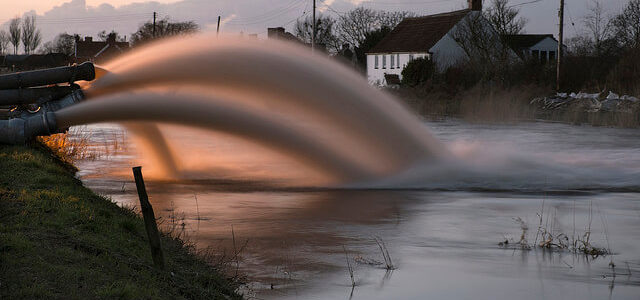Small Commercial Premises or Large Industrial Unit? Which Sump Pump Will Protect Against Flood Disasters?
A total of 38 water sump pumps were brought in across key areas of South Yorkshire to deal with the recent disaster flooding emergency, according to the Environment Agency (EA). Pumps were installed in eight separate locations in Fishlake alone, one of the worst hit areas in Doncaster where the entire village of around 200 properties and its community of 700 people were evacuated.
The EA also reported that 1.25 million tonnes of water were pumped in a 24 hour period, which helped reduce water levels in the village from 2 metres to 0.3 metres – a huge drop of 85 per cent (GOV.UK). Despite 50 million litres of water moved per hour, more pumps were set to be installed as further rain began to fall.
Article Chapters
A specific solution for removing particular liquids
The regularity of catastrophic flooding events across the UK increasingly highlights the crucial role that sump pump play in high volume water removal. But there are many types and sizes of pumps, each designed to provide a specific solution for removing particular liquids, solids, sewage, oils, chemicals, etc.
While a range of sumps pumps are specified for average size residential properties, they may not be correct or sufficient for larger commercial premises or industrial units. A key difference could be whether a pump is to be used for high outlet pressure or high discharge, the type of liquid content to be pumped and the required pressure or flow rate required in each case to remove the liquid.
High outlet pressure or high discharge?
A Positive Displacement (PD) Pump – also known as a ‘Reciprocating Pump’ – can often be specified when high outlet pressure is required. Rotating or ‘reciprocating parts’ directly force the liquid within an enclosed volume, until sufficient pressure is built up to move the liquid into the discharge system.
Normal application can be within industrial environments where there is a need for ‘low flow and high pressure’ to move liquids gently, such as high viscosity fluids, types of thinner fluids, fluids containing solids, especially fragile solids, and shear sensitive liquids.
A Centrifugal Pump – also referred to as a ‘Dynamic Pump’ – will be used when high discharge is needed, as in the removal of high volumes of water by one or more impellers. Recommended for producing the highest flow rates and for lower viscosity liquids, the centrifugal pump can quickly move all sorts of clean and dirty liquids (depending on impeller type) including, most importantly, water.
However, it is also recommended that a full site audit should always be carried out by expert and experienced sump pump specialists, which will correctly determine exact requirements in each specific location and their required application.
READ MORE: 1 in 10 Properties in UK Built on a Floodplain – a Sump Pump is Essential!
Qualified Full Site Audits Ensure The Correct Pump Is Installed!
Protect your warehouse or industrial premises!
A full site audit will ensure your sump pumps will do the job required.
TEL 01634 215192


Comments are closed.